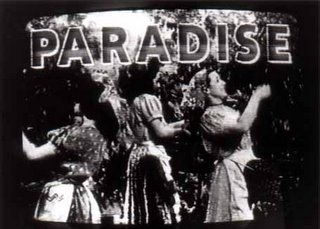The Gringo in Mañanaland
DeeDee Halleck's The Gringo in Mañanaland is composed of several hundred clips showing US film portrayals of Latin America from around 1910 to 1960.
The most recent film cited is, in fact, the 1963 Fun in Acapulco, but the majority of Halleck's sources are from the period 1925-1955 and so cover the height of "good neighborliness."
Films spotlighted include Flight (1929), The Stoker (1932), Marines Fly High (1940), Carnival in Costa Rica (1947), Tropic Zone (1953, with a young Ronald Reagan), and The Naked Jungle (1954), but also many others. In addition to fiction and feature films, Halleck incorporates newsreels, promotional films, and documentaries.
The Gringo in Mañanaland shapes this collage into one overarching plot, articulated in terms of the film's titled subsections: "Arrival," "The Past," "Paradise," "Ambition," "Problem #1" (white women), "Thrift," "Problem #2" (armed men), "Technology," "Cooperation," and "Partners."
As Halleck herself puts it, the narrative that emerges is, in brief, that "the hero discovers paradise and bananas, he has a problem with bandits and women, he calls in the marines, the bandits cooperate, and the good neighbors are happy." From Paradise Found to Paradise Profitably Exploited to Paradise Lost to Paradise Regained, all thanks to US enterprise and US armed enforcement.

Halleck suggests that this narrative combines "the essential Latin American stereotypes." I'd say, rather, that it's in the very nature of a stereotype to be inessential: there is always, in other words, something arbitrary or excessive about a stereotype, however recognizable or intuitive it may be.
The plot that The Gringo in Mañanaland distils certainly resonates not only with the pre-WWII period of American interventionism (in Cuba and Puerto Rico, Haiti and Nicaragua, and elsewhere), but also especially with the Reagan era's tragi-comic return to gunboat diplomacy. After all, Halleck began her project in the 1980s, during which time she was also very invested in Central American, and particularly Nicaraguan, solidarity.
But each generation constructs the Latin America that it deserves. And to argue that that the stories told about the region are always only about the armed enforcement of economic exploitation is as simplifying, reductive, and, in the end, misleading as any of the "stereotypes" that are here subject to critique.
The most recent film cited is, in fact, the 1963 Fun in Acapulco, but the majority of Halleck's sources are from the period 1925-1955 and so cover the height of "good neighborliness."
Films spotlighted include Flight (1929), The Stoker (1932), Marines Fly High (1940), Carnival in Costa Rica (1947), Tropic Zone (1953, with a young Ronald Reagan), and The Naked Jungle (1954), but also many others. In addition to fiction and feature films, Halleck incorporates newsreels, promotional films, and documentaries.
The Gringo in Mañanaland shapes this collage into one overarching plot, articulated in terms of the film's titled subsections: "Arrival," "The Past," "Paradise," "Ambition," "Problem #1" (white women), "Thrift," "Problem #2" (armed men), "Technology," "Cooperation," and "Partners."
As Halleck herself puts it, the narrative that emerges is, in brief, that "the hero discovers paradise and bananas, he has a problem with bandits and women, he calls in the marines, the bandits cooperate, and the good neighbors are happy." From Paradise Found to Paradise Profitably Exploited to Paradise Lost to Paradise Regained, all thanks to US enterprise and US armed enforcement.

Halleck suggests that this narrative combines "the essential Latin American stereotypes." I'd say, rather, that it's in the very nature of a stereotype to be inessential: there is always, in other words, something arbitrary or excessive about a stereotype, however recognizable or intuitive it may be.
The plot that The Gringo in Mañanaland distils certainly resonates not only with the pre-WWII period of American interventionism (in Cuba and Puerto Rico, Haiti and Nicaragua, and elsewhere), but also especially with the Reagan era's tragi-comic return to gunboat diplomacy. After all, Halleck began her project in the 1980s, during which time she was also very invested in Central American, and particularly Nicaraguan, solidarity.
But each generation constructs the Latin America that it deserves. And to argue that that the stories told about the region are always only about the armed enforcement of economic exploitation is as simplifying, reductive, and, in the end, misleading as any of the "stereotypes" that are here subject to critique.
Labels: documentary, geopolitics
